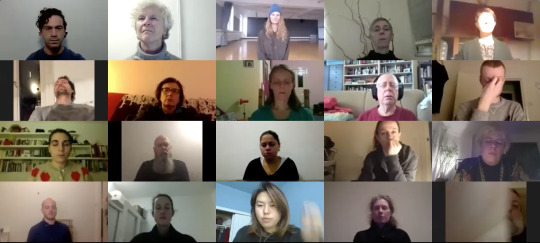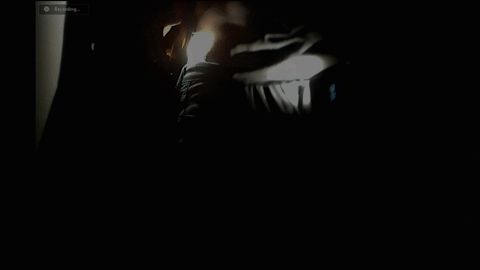#networked spaces
Distant Feeling(s) #7 | December 7th, 6PM GMT+1
Distant Feeling(s) 7th, activated on December 7th, 2019, was the third annual activation of the Distant Feeling(s) project, inviting all interested to participate in a shared moment of togetherness across a distance.
Using the internet’s potential of connectivity as a means to reflect on the constraints and limitations of that precise quality, DF has become (since its first iteration in 2015*) a participatory event in which through silence and provoking an inwards movement by the closing of the eyes while connected, which aims to highlight the relational aspect that is (supposedly) intrinsic to the idea of network. Throughout its various activations, from a closed environment between the artists Annie Abrahams, Lisa Parra and Daniel Pinheiro – where the main focus was to attempt sensing the existence and presence of the others while being physically distant, without speaking and with eyes closed – to it becoming a practice shared with an audience, and transforming into an open event since 2017, the project has addressed, cumulatively, the characteristics of the medium/infrastructure to reflect upon them, producing an archive of documentation of the various moments where each one and all work as a visual metaphor of the condition(ing) of connectivity as it is installed in our lives.
A silent, yet sentient, relational encounter, materialized as a telematic embrace where nothing seems to happen and where the lack of apparent action has transformed into the transposition of the concept of agency and a potential way for fighting alienation.
In the more recent activations of the project, a common fact has been the awareness of how machines and the surrounding environments from the different remote locations become present* while the bodies perform a sort of absentia while electricity powers this moment of communion. Where and how are we (always) while the network is functioning?
As it continues to develop, iteration after iteration, whether it is through the annual re-activations or in specific contexts it becomes clear that it is a form of researching togetherness through the internet as a way to counter its fallacy, the promise of a interconnected world where concepts of time and physical space dissipate** (an ubiquitous spatio-temporal unity), which in fact drives today the (im)possibility of collective strength/power. It is a provocation to the role of networked conversations as a practice for activism emptied from specific purpose, again, assuming the role of symbolizing a situation of engaging in different possibilities of triggering collective agency.
Can we find novelty in an already established system, and act from within, towards (an)other purpose(s)?
Distant Feeling(s) highlights in its genesis and continuity the need to feel/sense presence and suggests a pragmatical approach for reshaping a consciousness on kinship resorting to available technological tools which have been transforming its meaning.
“Silence is hard to find…” Camille Renarhd mentions at the end of DF#7 and it is through this quest for silence where machines, responsible for allowing the connection across a distance, “speak” louder and the contemporary restlessness is confronted in this model of interaction between humans and machines. It is not a proposition for a revolution nor a resolution for an evident relational crisis, it is an experience on connectivity and its fundamentals.
The relational revolution is already far along.
At the same time, it is clearly in crisis. – Time Reborn p. xxix

Distant Feeling(s) is a project initiated by Annie Abrahams, Lisa Parra and Daniel Pinheiro
Participants of Distant Feeling(s) #7: Camille Renarhd, Daniel Pinheiro, Muriel Piqué, Annie Abrahams, Bérénice Belpaire, Nicolaas Schmidt, Christine Develotte, Sandra Sarala, Alan Sondheim, Paul Hughes, Nerina Cocchi, Frans Van Lent, Ariane Cassimiro, Frédérique Santune, Camille Bloomfield, Jonathan Chomko, Csenge Kolozsvári, Sabrina Kwong, Ienke Kastelein, Molly Hankwitz, David Cox
space(s) is another encounter between Lisa Parra ( @parralis ) and Daniel Pinheiro ( @daniel-pinheiro ) exploring the possibilities of the networked environment.
Space is a practiced place. Thus the street geometrically defined by urban planning is transformed into a space by walkers. In the same way, an act of reading is a space produced by the practice of a particular place: a written text, i.e.: a place constituted by a system of signs. - Michel De Certeau
(De Certeau, ‘The Practice of Everyday Life’, 117, quoted in Kaye, 'Site-Specific Art: Performance, Place and Documentation, 4; quoted in Steve Dixon’s 'Digital Performance - A History of New Media in Theater, Dance, Performance Art, and Installation’, 411)

In the darkness,
We move forward,
in an unknown territory,
a territory devoid of references,
without meaning.
As we move ahead,
as we go through the surface,
through the edges,
as we follow the contours,
we intersect shapes and elements.
In that space,
it becomes…
impossible to perceive what we intersect.
We resort to memory,
to reproduce what we think
we are in fact intersecting.
We resort to memory,
of things we already know,
so we can name the things,
and make that space,
somehow recognizable.
In that space,
where distance is impossible to measure,
we try…
that opacity becomes lesser…
where are you when you’re not here?!
-Placelessness, 2015; LAND PROJECT

As the place - space - is built by a relationship of coexistence; remote places become a single distributed continuous area expanded through a networked system of communication - the specificity of this place [site-specific] is a consequence of what happens within it. The personal sense of position, in regard to common referentials, is disrupted by fracturing the distance between (at least) two physical locations. This perception is an altered state caused by a sensorial experience of practicing this new multi-location extended placelessness inhabited by actions that, through light, gradually unveil a unified mixed reality.
By playing with the possibility offered by darkness and with light, the doubled space is demarcated by the actions developed, its liminality allows for a careful disorientation of participants inviting them to ‘enter’ each other’s distinct location and compose a representation of what’s being simultaneously constructed.
The body finds itself in the middle of this ambiguity, no longer claiming a singular identity but possibly assuming the other as an extension of its own. These ambiguous bodies are constantly in a state of becoming, a transdividual exchange that is a writing of this space, only tangible through its embodiment – its practice, constituting an archetypal system.

Through the screen, both the sense of presence (body) and space (place), within networked environments are exerted to the extent that they undermine traditional preconceptions of their significance. This non-place is a constant transitory state between the physical and the immateriality of its augmentation; inhabited by its agents/actors it becomes a site-specific where both the perception of location and self are shared between them, a communicant place where one end is not a copy of the other, where both are real and coexist in the same time – this one limited to the length of its duration – an area of action, liberated from normative constraints.

see time lapse video of the encounter here.
